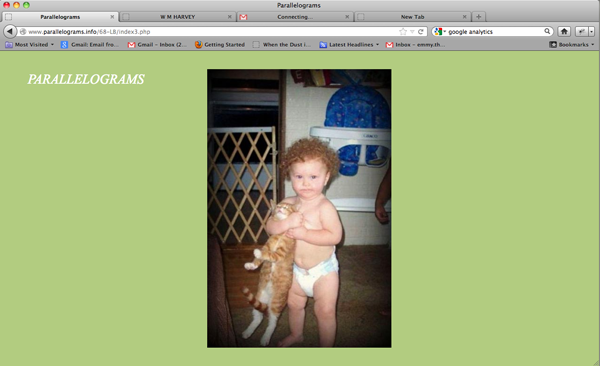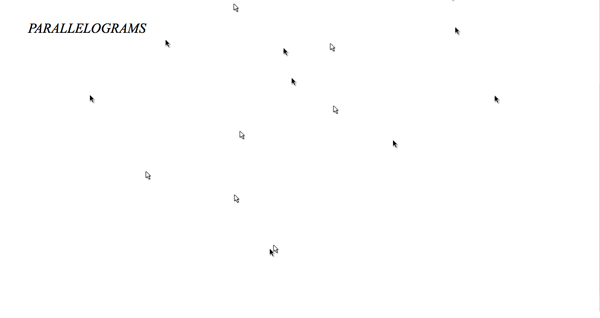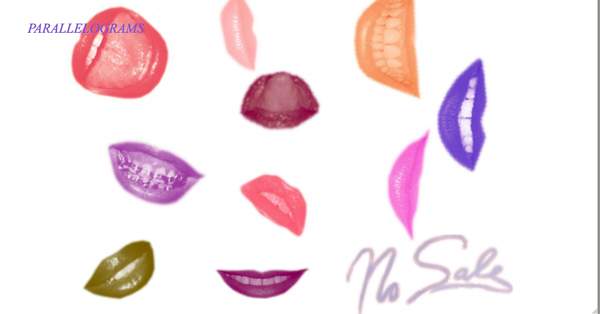11.10.12 Interview with Leah Beeferman and Matthew Harvey about Parallelograms by Emmy Thelander
Walter Benjamin’s essay, “The Work of Art in the Age of Its Technological Reproducibility” initiated a conversation about the reproduced image’s loss of specific time and place. David Joselit reexamines Benjamin’s text in his latest book, After Art, in light of the dispersion of images produced by the internet. In the first chapter, “Image Explosion,” Joselit equates Benjamin’s concept of aura with site-specificity; writing in regards to the incredible dissemination of images today, he states, “Images are no longer and probably can never again be site specific…” (I)
Leah Beeferman and Matthew Harvey’s project, Parallelograms, asks artists to use the browser window as the context for a work of art. Although, like the reproducible image, the browser is “everywhere at once” (II) and its parameters are variable, these qualities paradoxically become the criteria for site-specificity on the web.
Matthew and Leah provide the artist with a jpeg they have culled from Google searches and the artist formulates a response coded in HTML. Some of the responses are interactive (a series of loosely related jpegs the viewer can click through or a text adventure game) while some are single pages with moving images or sound. A defining trait of the artists’ responses is that most activate the full space of the browser (unlike a typical website with margins), highlighting that the viewer’s window is the intended locale of the work.
Following is an e-mail exchange I engaged in with Leah and Matthew about Parallelograms. Matthew was traveling in Berlin for work, but Leah was able to act as the middle point to coordinate our trans-Atlantic communication.
Emmy Thelander: How did you two form the idea behind Parallelograms?
Leah Beeferman and Matthew Harvey: In part, it was an offshoot of another project we used to do, called Tessellations, in which we would alternate posting found images to create some kind of narrative. That project ran for several years, and we hoped to find a way to get other artists involved but we never figured it out. Parallelograms came up, initially, as an idea in response to this desire.
Ultimately, though, Parallelograms is a way to approach other ideas we had both been thinking about, otherwise: meanings of and potential for found images, and an interest in broad “artistic process” and how different types of artists, designers, etc. respond to material and generate ideas. We’re interested in how an artist’s practice is impacted by the massive number of images he/she encounters on the internet, both actively and casually. With Parallelograms, we wanted to provide a wide range of creative individuals with a place to engage in generative internet processes; but rather than simply reposting found images (as with other blogs or tumblrs), they would create new work from the mass of “stuff” found on the internet.
Of course, Parallelograms is about making art for the web rather than just putting work on the web, and trying to initiate some new kind of activity that would encourage artists to think about the web as an opportunity for “site-specific” work rather than merely a place to put a portfolio and publicize oneself.
Finally, we are both very excited by and involved with printed matter, in its various forms. We’re both artists who use and think about books and publications regularly, and Matt works as production manager for a photography publisher in Manhattan, so deals with books and printing on a daily basis (that’s why he’s in Europe right now, actually, printing). Parallelograms is in large part inspired by printed publications and distribution, and that helped inspire our initial schedule of publishing one project every week (unfortunately, we’re not able to keep up that pace anymore), compiling a mailing list, etc.
ET: What were your expectations for the project and how have the results differed?
LB and MH: We’re not sure either of us expected it to last this long! It’s become the project that never ends, as we constantly discover new artists and designers who we want to invite. But, we’re also not sure we knew what to expect. It was a spur of the moment idea when we were out to dinner one night a few years ago, after which Leah said, “I know who to invite first.” And we just ran with it, since those friends (excellent designers Everything Studio) pulled through with an amazing first project. When Parallelograms began, we imagined or, really, hoped that it would be something like it is. Realistically, it’s surpassed anything we could have initially expected.
ET: Do you find that the space of the web browser challenges the artists to make pieces they would not otherwise think about making?
LB and MH: For a lot of people, yes, and for others, no. We’ve tried to invite a really broad range of creative people: painters, sound artists, graphic designers, video artists, net artists, writers…. knowing that everyone would have a different process and type of response. We have purposely invited many people who seem to have no relationship to technology or to the web specifically, to try and get them to think about this space of the web browser as a potential and active space, rather than, again, a depository. It’s been fascinating talking with different people as they approached their projects, seeing different processes, implementing ideas…
ET: Do the artists program the pages themselves? Do they ever ask for your assistance?
LB and MH: It varies quite a bit. We’ve had several people just hand over a .zip file with everything set up on web pages and self-contained, and others who said, “Here are my elements, I have no idea how to make this but this is what I want it to do.” Leah, a visual and sound artist herself, earns her keep doing freelance web work, so it’s familiar territory for her to figure things out and build projects. Matt’s learned quite a bit about coding over the years, and together we build (or piece together) anything the artists themselves are unable to do, again, sometimes nothing, sometimes a little, and sometimes a lot. Also, certain projects have developed collaboratively as a back-and-forth between us and an artist who has a loose idea and needs feedback about how to frame it for the web, or is just looking for feedback in general. It’s always fun when we get to be involved as the ideas grow.
ET: Are there any internet artists/projects you particularly admire? Do you actively seek out this kind of work?
LB and MH: Jogging is one of the most interesting repositories for creative internet practices; also, of course, Computers Club and Nasty Nets. We don’t actively seek out internet more than any other kind of work, and actually, it’s been very important for us to make sure that just because Parallelograms is a “web project” that we don’t prioritize “web artists” over anyone else. Sure, there are tons of internet pieces we’ve seen that we love, but we love equal numbers of painters, designers, sound artists.
ET: What do you see as the challenges for web-based art and design projects? Do you think that more artists will embrace the web as a medium in the future or do you find that many are resistant to it?
LB and MH: Some challenges might be issues of digital preservation for the web, cross-browser or cross-technology compatibility, and the traditional art world and, of course, lack of coding/programming knowledge. But many other web-based or internet art sites and artists are attacking these problems to make this future happen more seamlessly. Hopefully more artists will embrace the web as a medium, it has so much of its own potential and its own “material” concerns that could be addressed. Almost everyone we’ve asked who does not have a web or technology background or who does not make work using technology or the internet has jumped at the opportunity to make a project for Parallelograms, especially since we offer to help code. If every artist knew how to build web pages, perhaps web-based projects would happen a lot more casually, and frequently.
Working on browser-based works can require a lot of collaboration, thus bringing a lot of different creative individuals from various backgrounds together. There is so much unexplored potential for the web, both for audiences and artists alike. Coding takes time, but as more of the world becomes browser ‘literate’ in terms of what is possible, more and more interesting projects will arise. Finally, we think there is huge potential for the iPhone and iPad, which is not yet easily accessed. Once pieces for these types of platforms become more commonly traded in the art world, it will probably become a lot more common for artists with no web/screen background to experiment with it (a la David Hockney’s iPad drawings, etc.).
ET: How do you source the images you send to the artists and are there any criteria for their choosing?
LB and MH: All of our images come from frequent Google image searches that we do both separately and together. At this point, we both have enormous collections of found images on our respective computers, which we’ll get together and sort for the artists we’re inviting. Sometimes we search together, with a particular artist in mind, and sometimes not. But the sorting process is crucial: it requires us to be familiar with an artist’s work and ideas so we can give images that are relevant but not obvious, and can provide a challenge yet also be inspiring. The searching takes quite a bit of time, but it’s incredibly fun, and we’ve come across some really amazing images and sites along the way.
I Joselit, David. After Art, Princeton: Princeton University Press, 2012, p. 14.
II Ibid, p. 16.
Matthew Harvey is a photographer and amateur hobbyist. He currently makes books for Aperture as their Production Manager. wmmh.net
Leah Beeferman is a visual and sound artist working with many different, but unified, processes. She frequently builds and designs things for the web, but mostly for others. leahbeeferman.com
They both live in New York City.
Tags: Journal

